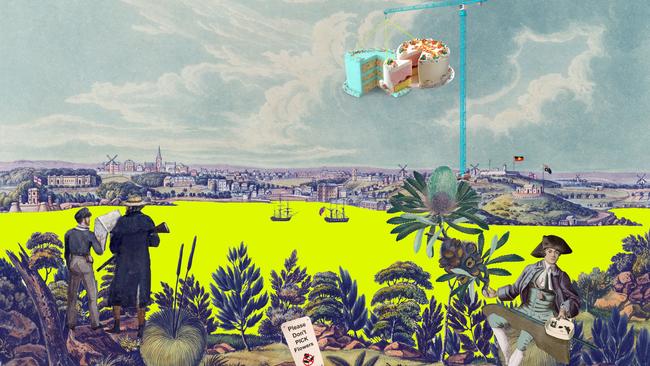History re-shaped for a modern audience
Scottish-born Australian artist Joan Ross brings a unique perspective to the discussion of our contentious colonial past.

Ever since Joan Ross was a young child, she has, she says, “loved forgers”, and the first video she made was called When I grow up I want to be a forger. It is not surprising therefore that Ross would be attracted to Joseph Lycett, who besides being a successful colonial artist was also a forger. In 1811, Lycett was convicted of forging bank notes in England and was transported to NSW. But Lycett was luckier than most convicts because he came to the attention of Governor Lachlan Macquarie, was commissioned to paint the colony, and consequently produced many landscapes.
For nearly 10 years, Ross, who was born in Glasgow but is now based in Sydney, has been appropriating Lycett’s landscapes through a range of media such as video, drawing and digital printmaking. She describes Lycett’s paintings as a “perfect vehicle” — a springboard to discuss this colonial period of history. “I also use these works because I know people love landscape,” she says, “and it’s a way for people to see other perspectives.” It is part of Ross’s longstanding critique of British colonisation and its negative impacts, which she examines through a combination of humour and the absurd. A signature feature of her work is the way she adds fluorescent “hi-vis” yellow motifs into Lycett’s images.
In one of her latest commissions, Ross has appropriated five Lycett paintings of Sydney Harbour. Titled We have sung the same song for millions of years, it is 20m long and has been installed on the hoarding surrounding the construction site of the Art Gallery of NSW’s Sydney Modern project. In addition, she has made a hand-coloured pigment print based on the AGNSW commission. The print, titled Please Don’t Pick the Flowers, 2019, is a recent acquisition for the Manly Art Gallery & Museum in Sydney, and can be viewed online at https://www.northernbeaches.nsw.gov.au/things-to-do/whats-on/treasures-from-the-vault.
The print features settlers in Regency dress, as well as birds, animals and plants as a reminder of the loss of habitat and species. There are also aspects from contemporary life such as a party cake, construction cranes and the Aboriginal flag. However, perhaps the most attention-grabbing element is a fluorescent yellow Sydney Harbour, which, Ross says, signifies colonial possession of indigenous land. “The work seeks to remind us of colonialism’s ongoing presence and effects,” she says. “I want to acknowledge the longevity of Australian indigenous culture as well as the enduring history of Australia’s endemic plants and animals.”
At the Manly Art Gallery & Museum, senior curator Katherine Roberts describes Ross as a “fascinating artist”. “The irony and metaphor used in Ross’s contemporary interpretations of colonial etchings provide a new way for us to understand that time and the present,” she says. “In this work, the crane with its suspended slice of cake adds an absurdity to the scene and pulls it startlingly into the present, along with the hi-vis harbour. As the Manly Art Gallery & Museum marks its 90th year on the edge of Sydney Harbour, it is only right that we think about ideas around the appropriation of this site and the role art can play in discussing Sydney’s contested history.”
-
Saleroom
Adam Cullen, who died in 2012 at the age of 47, was known for his portraits of high-profile Australians. He won the 2000 Archibald Prize for his portrait of actor David Wenham. Cullen was considered controversial for incidents such as chaining a rotting pig’s head to his ankle for two weeks while he was at art school, and for being pulled over by the police who found firearms in his car. He also collaborated with his friend, convicted criminal Mark “Chopper” Read, on a book and painted him for the 2002 Archibald. Cullen was proud of his Irish heritage and this is reflected in one of his paintings titled Irish Darcy, which was the top sale at a recent Shapiro online auction of Australian and international art. Irish Darcy sold for $21,600 (including buyer’s premium), well above its pre-sale estimate of $5000 to $7000. The second-highest sale was Place Dauphine, Paris, from 1950 by Margaret Olley, which sold for $15,600. Other sales included Ray Crooke’s Lei Making, 1979, which fetched $14,400, and Jon Molvig’s Nude in a Butcher’s Shop, 1965, which also fetched $14,400. Full auction results can be viewed at https://www.shapiro.com.au/
Bronwyn Watson



To join the conversation, please log in. Don't have an account? Register
Join the conversation, you are commenting as Logout